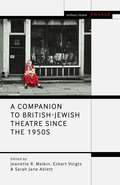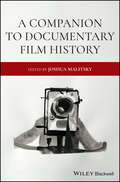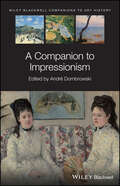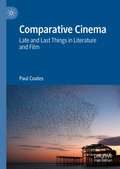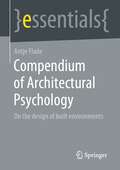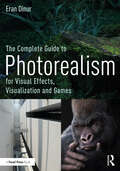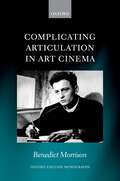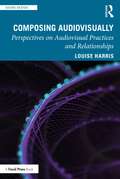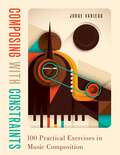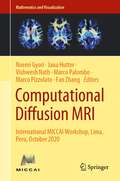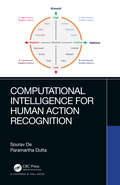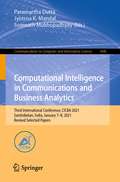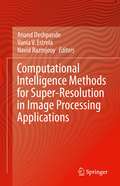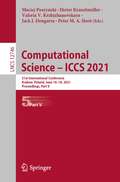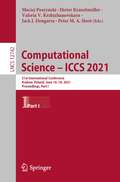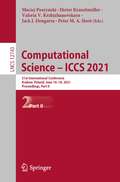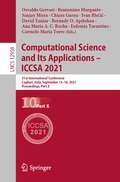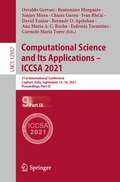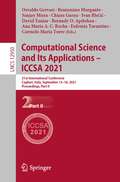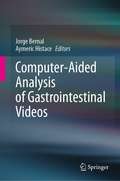- Table View
- List View
A Companion to British-Jewish Theatre Since the 1950s (Methuen Drama Engage)
by Jeanette R. Malkin, Eckart Voigts and Sarah Jane AblettThe first of its kind, this companion to British-Jewish theatre brings a neglected dimension in the work of many prominent British theatre-makers to the fore. Its structure reflects the historical development of British-Jewish theatre from the 1950s onwards, beginning with an analysis of the first generation of writers that now forms the core of post-war British drama (including Tom Stoppard, Harold Pinter and Arnold Wesker) and moving on to significant thematic force-fields and faultlines such as the Holocaust, antisemitism and Israel/Palestine. The book also covers the new generation of British-Jewish playwrights, with a special emphasis on the contribution of women writers and the role of particular theatres in the development of British-Jewish theatre, as well as TV drama. Included in the book are fascinating interviews with a set of significant theatre practitioners working today, including Ryan Craig, Patrick Marber, John Nathan, Julia Pascal and Nicholas Hytner. The companion addresses, not only aesthetic and ideological concerns, but also recent transformations with regard to institutional contexts and frameworks of cultural policies.
A Companion to Documentary Film History
by Joshua MalitskyThis volume offers a new and expanded history of the documentary form across a range of times and contexts, featuring original essays by leading historians in the field In a contemporary media culture suffused with competing truth claims, documentary media have become one of the most significant means through which we think in depth about the past. The most rigorous collection of essays on nonfiction film and media history and historiography currently available, A Companion to Documentary Film History offers an in-depth, global examination of central historical issues and approaches in documentary, and of documentary's engagement with historical and contemporary topics, debates, and themes. The Companion's twenty original essays by prominent nonfiction film and media historians challenge prevalent conceptions of what documentary is and was, and explore its growth, development, and function over time. The authors provide fresh insights on the mode's reception, geographies, authorship, multimedia contexts, and movements, and address documentary's many aesthetic, industrial, historiographical, and social dimensions. This authoritative volume: Offers both historical specificity and conceptual flexibility in approaching nonfiction and documentary media Explores documentary's multiple, complex geographic and geopolitical frameworks Covers a diversity of national and historical contexts, including Revolution-era Soviet Union, post-World War Two Canada and Europe, and contemporary China Establishes new connections and interpretive contexts for key individual films and film movements, using new primary sources Interrogates established assumptions about documentary authorship, audiences, and documentary's historical connection to other media practices. A Companion to Documentary Film History is an ideal text for undergraduate and graduate courses covering documentary or nonfiction film and media, an excellent supplement for courses on national or regional media histories, and an important new resource for all film and media studies scholars, particularly those in nonfiction media.
A Companion to Documentary Film History
by Joshua MalitskyThis volume offers a new and expanded history of the documentary form across a range of times and contexts, featuring original essays by leading historians in the field In a contemporary media culture suffused with competing truth claims, documentary media have become one of the most significant means through which we think in depth about the past. The most rigorous collection of essays on nonfiction film and media history and historiography currently available, A Companion to Documentary Film History offers an in-depth, global examination of central historical issues and approaches in documentary, and of documentary's engagement with historical and contemporary topics, debates, and themes. The Companion's twenty original essays by prominent nonfiction film and media historians challenge prevalent conceptions of what documentary is and was, and explore its growth, development, and function over time. The authors provide fresh insights on the mode's reception, geographies, authorship, multimedia contexts, and movements, and address documentary's many aesthetic, industrial, historiographical, and social dimensions. This authoritative volume: Offers both historical specificity and conceptual flexibility in approaching nonfiction and documentary media Explores documentary's multiple, complex geographic and geopolitical frameworks Covers a diversity of national and historical contexts, including Revolution-era Soviet Union, post-World War Two Canada and Europe, and contemporary China Establishes new connections and interpretive contexts for key individual films and film movements, using new primary sources Interrogates established assumptions about documentary authorship, audiences, and documentary's historical connection to other media practices. A Companion to Documentary Film History is an ideal text for undergraduate and graduate courses covering documentary or nonfiction film and media, an excellent supplement for courses on national or regional media histories, and an important new resource for all film and media studies scholars, particularly those in nonfiction media.
A Companion to Impressionism (Blackwell Companions to Art History)
by Dana ArnoldA Companion to Impressionism Presenting an expansive view of the study of Impressionism, this pioneering volume breaks new thematic ground while also reconsidering questions concerning the definition, chronology, and membership of the impressionist movement. In 34 original essays from established and emerging scholars, this collection offers a diverse range of developing topics and new critical approaches to the interpretation of impressionist art. Focusing on the 1860s to 1890s, A Companion to Impressionism explores artists who are well-represented in impressionist studies, including Monet, Renoir, Degas, and Cassatt, as well as Morisot, Caillebotte, Bazille, and other significant yet lesser-known artists. The essays cover a wide variety of methodologies in addressing such topics as Impressionism’s global predominance at the turn of the 20th century, the relationship between Impressionism and the emergence of new media, the materials and techniques of the Impressionists, as well as the movement’s exhibition and reception history. This innovative volume also includes new discussions of modern identity in Impressionism in the contexts of race, nationality, gender, and sexuality and through its explorations of the international reach and influence of Impressionism. Part of the acclaimed Wiley Blackwell Companions to Art History series, this important addition to scholarship in this field stands as the 21st century’s first major and large-scale academic reassessment of Impressionism. Featuring essays by academics, curators, and conservators from around the world, including those from France, Germany, the United States, the United Kingdom, Japan, Turkey, and Argentina, this is an invaluable text for students and scholars studying Impressionism and late 19th-century European art, Post-Impressionism, modern art, and modern French cultural history.
A Companion to Impressionism (Blackwell Companions to Art History)
by Dana ArnoldA Companion to Impressionism Presenting an expansive view of the study of Impressionism, this pioneering volume breaks new thematic ground while also reconsidering questions concerning the definition, chronology, and membership of the impressionist movement. In 34 original essays from established and emerging scholars, this collection offers a diverse range of developing topics and new critical approaches to the interpretation of impressionist art. Focusing on the 1860s to 1890s, A Companion to Impressionism explores artists who are well-represented in impressionist studies, including Monet, Renoir, Degas, and Cassatt, as well as Morisot, Caillebotte, Bazille, and other significant yet lesser-known artists. The essays cover a wide variety of methodologies in addressing such topics as Impressionism’s global predominance at the turn of the 20th century, the relationship between Impressionism and the emergence of new media, the materials and techniques of the Impressionists, as well as the movement’s exhibition and reception history. This innovative volume also includes new discussions of modern identity in Impressionism in the contexts of race, nationality, gender, and sexuality and through its explorations of the international reach and influence of Impressionism. Part of the acclaimed Wiley Blackwell Companions to Art History series, this important addition to scholarship in this field stands as the 21st century’s first major and large-scale academic reassessment of Impressionism. Featuring essays by academics, curators, and conservators from around the world, including those from France, Germany, the United States, the United Kingdom, Japan, Turkey, and Argentina, this is an invaluable text for students and scholars studying Impressionism and late 19th-century European art, Post-Impressionism, modern art, and modern French cultural history.
Comparative Cinema: Late and Last Things in Literature and Film
by Paul CoatesThis book comprises what may be called exercises in ‘comparative cinema’. Its focus on endings, near-endings and ‘late style’ is connected with the author’s argument that comparative criticism itself may constitute an endgame of criticism, arising at the moment at which societies or individuals relinquish primary adherence to one tradition or medium. The comparisons embrace different works and artistic media and primarily concern works of literature and film, though they also consider issues raised by the interrelationship of language and moving and still images, as well as inter- and intra-textuality. The works probed most fully are ones by Theo Angelopoulos, Ingmar Bergman, Harun Farocki, Theodor Fontane, Henry James, Krzysztof Kieślowski, Chang-dong Lee, Roman Polański, Thomas Pynchon, and Paul Schrader, while the key recurrent motifs are those of dusk, the horizon, the labyrinth, and the ruin.
Compendium of Architectural Psychology: On the design of built environments (essentials)
by Antje FladeThis essential provides planning-relevant information on architectural psychology concepts and empirical results on the effects of built environments on people, and provides guidance on how to optimize the relationship between people and the built environment. This Springer essential is a translation of the original German 1st edition essentials, Kompendium der Architekturpsychologie by Antje Flade, published by Springer Fachmedien Wiesbaden GmbH, part of Springer Nature in 2020. The translation was done with the help of artificial intelligence (machine translation by the service DeepL.com). A subsequent human revision was done primarily in terms of content, so that the book will read stylistically differently from a conventional translation. Springer Nature works continuously to further the development of tools for the production of books and on the related technologies to support the authors.
The Complete Guide to Photorealism for Visual Effects, Visualization and Games
by Eran DinurThis book offers a comprehensive and detailed guide to accomplishing and perfecting a photorealistic look in digital content across visual effects, architectural and product visualization, and games. Emmy award-winning VFX supervisor Eran Dinur offers readers a deeper understanding of the complex interplay of light, surfaces, atmospherics, and optical effects, and then discusses techniques to achieve this complexity in the digital realm, covering both 3D and 2D methodologies. In addition, the book features artwork, case studies, and interviews with leading artists in the fields of VFX, visualization, and games. Exploring color, integration, light and surface behaviour, atmospherics, shading, texturing, physically-based rendering, procedural modelling, compositing, matte painting, lens/camera effects, and much more, Dinur offers a compelling, elegant guide to achieving photorealism in digital media and creating imagery that is seamless from real footage. Its broad perspective makes this detailed guide suitable for VFX, visualization and game artists and students, as well as directors, architects, designers, and anyone who strives to achieve convincing, believable visuals in digital media.
The Complete Guide to Photorealism for Visual Effects, Visualization and Games
by Eran DinurThis book offers a comprehensive and detailed guide to accomplishing and perfecting a photorealistic look in digital content across visual effects, architectural and product visualization, and games. Emmy award-winning VFX supervisor Eran Dinur offers readers a deeper understanding of the complex interplay of light, surfaces, atmospherics, and optical effects, and then discusses techniques to achieve this complexity in the digital realm, covering both 3D and 2D methodologies. In addition, the book features artwork, case studies, and interviews with leading artists in the fields of VFX, visualization, and games. Exploring color, integration, light and surface behaviour, atmospherics, shading, texturing, physically-based rendering, procedural modelling, compositing, matte painting, lens/camera effects, and much more, Dinur offers a compelling, elegant guide to achieving photorealism in digital media and creating imagery that is seamless from real footage. Its broad perspective makes this detailed guide suitable for VFX, visualization and game artists and students, as well as directors, architects, designers, and anyone who strives to achieve convincing, believable visuals in digital media.
Complicating Articulation in Art Cinema (Oxford English Monographs)
by Benedict MorrisonComplicating Articulation in Art Cinema argues that art cinema draws attention to its disjointed, multi-parted form, but that criticism has too frequently sought to explain this complexity away by stitching the parts together in totalizing readings. This stitching together has often relied on the assumption that the solution to art cinema's puzzles lies in interpreting each film as the expression of a focalizing character's internal disturbance. This book challenges this assumption. It argues that the attempt to explain formal complexity through this character-centric approach reduces formal achievements and enigmatic characters to inadequate approximations of one another. Reference to character cannot fully tame unschematic and unpredictable combinations of - and collisions between - contradictory levels of narration, clashing styles, discontinuously edited shots, jarring allusions, dislocated genre signifiers, and intermedial elements. Through close analyses of films by Roberto Rossellini, Robert Bresson, Luis Buñuel, Terence Davies, Peter Greenaway, and Kelly Reichardt, Complicating Articulation in Art Cinema offers an ethics of criticism that suggests that the politics of art cinema's eccentric form are limited by character-centred readings. Each of the featured films presents inarticulate characters, whose emotional and intellectual lives are unknowable, further complicating the relationship between character and form. This book argues that, by acknowledging this resistance to interpretation, critics can think in new ways about art cinema's interrogation of the possibilities of knowledge.
Composing Audiovisually: Perspectives on audiovisual practices and relationships (Sound Design)
by Louise HarrisWhat does the Coen Brothers’ Barton Fink have in common with Norman McLaren’s Synchromy? Or with audiovisual sculpture? Or contemporary music video? Composing Audiovisually interrogates how the relationship between the audiovisual media in these works, and our interaction with them, might allow us to develop mechanisms for talking about and understanding our experience of audiovisual media across a broad range of modes. Presenting close readings of audiovisual artefacts, conversations with artists, consideration of contemporary pedagogy and a detailed conceptual and theoretical framework that considers the nature of contemporary audiovisual experience, this book attempts to address gaps in our discourse on audiovisual modes, and offer possible starting points for future, genuinely transdisciplinary thinking in the field.
Composing Audiovisually: Perspectives on audiovisual practices and relationships (Sound Design)
by Louise HarrisWhat does the Coen Brothers’ Barton Fink have in common with Norman McLaren’s Synchromy? Or with audiovisual sculpture? Or contemporary music video? Composing Audiovisually interrogates how the relationship between the audiovisual media in these works, and our interaction with them, might allow us to develop mechanisms for talking about and understanding our experience of audiovisual media across a broad range of modes. Presenting close readings of audiovisual artefacts, conversations with artists, consideration of contemporary pedagogy and a detailed conceptual and theoretical framework that considers the nature of contemporary audiovisual experience, this book attempts to address gaps in our discourse on audiovisual modes, and offer possible starting points for future, genuinely transdisciplinary thinking in the field.
Composing with Constraints: 100 Practical Exercises in Music Composition
by Jorge VariegoComposing with Constraints: 100 Practical Exercises in Music Composition provides an innovative approach to the instruction of the craft of music composition based on tailored exercises to help students develop their creativity. When composition is condensed to a series of logical steps, it can then be taught and learned more efficiently. With this approach in mind, Jorge Variego offers a variety of practical exercises to help student composers and instructors to create tangible work plans with high expectations and successful outcomes. Each chapter starts with a brief note on terminology and general recommendations for the instructor. The first five chapters offer a variety of exercises that range from analysis and style imitation to the use of probabilities. The chapter about pre-compositional approaches offers original techniques that a student composer can implement in order to start a new work. Based on lateral thinking, the last section of the book fosters creative connections with other disciplines such as math, visual arts, and architectural acoustics. The one hundred exercises contain a unique set of guidelines and constraints that place students in a specific compositional framework. These compositional boundaries encourage students to produce creative work within a given structure. Using the methodologies in this book, students will be able to create their own outlines for their compositions, making intelligent and educated compositional choices that balance reasoning with intuition.
Computational Diffusion MRI: International MICCAI Workshop, Lima, Peru, October 2020 (Mathematics and Visualization)
by Noemi Gyori Jana Hutter Vishwesh Nath Marco Palombo Marco Pizzolato Fan ZhangThis book gathers papers presented at the Workshop on Computational Diffusion MRI, CDMRI 2020, held under the auspices of the International Conference on Medical Image Computing and Computer-Assisted Intervention (MICCAI), which took place virtually on October 8th, 2020, having originally been planned to take place in Lima, Peru.This book presents the latest developments in the highly active and rapidly growing field of diffusion MRI. While offering new perspectives on the most recent research challenges in the field, the selected articles also provide a valuable starting point for anyone interested in learning computational techniques for diffusion MRI. The book includes rigorous mathematical derivations, a large number of rich, full-colour visualizations, and clinically relevant results. As such, it is of interest to researchers and practitioners in the fields of computer science, MRI physics, and applied mathematics. The reader will find numerous contributions covering a broad range of topics, from the mathematical foundations of the diffusion process and signal generation to new computational methods and estimation techniques for the in-vivo recovery of microstructural and connectivity features, as well as diffusion-relaxometry and frontline applications in research and clinical practice.
Computational Intelligence for Human Action Recognition (Chapman & Hall/CRC Computational Intelligence and Its Applications)
by Sourav De Paramartha DuttaHuman Action Recognition is a challenging area presently. The vigor of research effort directed towards this domain is self indicative of this. With the ever-increasing involvement of Computational Intelligence in our day to day applications, the necessity of human activity recognition has been able to make its presence felt to the concerned research community. The primary drive of such an effort is to equip the computing system capable of recognizing and interpreting human activities from posture, pose, gesture, facial expression etc. The intent of human activity recognition is a formidable component of cognitive science in which researchers are actively engaged of late. Features: A systematic overview of the state-of-the-art in computational intelligence techniques for human action recognition. Emphasized on different intelligent techniques to recognize different human actions. Discussed about the automation techniques to handle human action recognition. Recent research results and some pointers to future advancements in this arena. In the present endeavour the editors intend to come out with a compilation that reflects the concerns of relevant research community. The readers would be able to come across some of the latest findings of active researchers of the concerned field. It is anticipated that this treatise shall be useful to the readership encompassing students at undergraduate and postgraduate level, researchers active as well as aspiring, not to speak of the senior researchers.
Computational Intelligence for Human Action Recognition (Chapman & Hall/CRC Computational Intelligence and Its Applications)
by Sourav De and Paramartha DuttaHuman Action Recognition is a challenging area presently. The vigor of research effort directed towards this domain is self indicative of this. With the ever-increasing involvement of Computational Intelligence in our day to day applications, the necessity of human activity recognition has been able to make its presence felt to the concerned research community. The primary drive of such an effort is to equip the computing system capable of recognizing and interpreting human activities from posture, pose, gesture, facial expression etc. The intent of human activity recognition is a formidable component of cognitive science in which researchers are actively engaged of late. Features: A systematic overview of the state-of-the-art in computational intelligence techniques for human action recognition. Emphasized on different intelligent techniques to recognize different human actions. Discussed about the automation techniques to handle human action recognition. Recent research results and some pointers to future advancements in this arena. In the present endeavour the editors intend to come out with a compilation that reflects the concerns of relevant research community. The readers would be able to come across some of the latest findings of active researchers of the concerned field. It is anticipated that this treatise shall be useful to the readership encompassing students at undergraduate and postgraduate level, researchers active as well as aspiring, not to speak of the senior researchers.
Computational Intelligence in Communications and Business Analytics: Third International Conference, CICBA 2021, Santiniketan, India, January 7–8, 2021, Revised Selected Papers (Communications in Computer and Information Science #1406)
by Paramartha Dutta Jyotsna K. Mandal Somnath MukhopadhyayThis book constitutes the refereed proceedings of the Third International Conference on Computational Intelligence, Communications, and Business Analytics, CICBA 2021, held in Santiniketan, India, in January 2021.The 12 full papers and 8 short papers presented in this volume were carefully reviewed and selected from 84 submissions. The papers are organized in topical sections on computational forensic (privacy and security); computational intelligence; data science and advanced data analytics; and intelligent data mining and data warehousing.
Computational Intelligence Methods for Super-Resolution in Image Processing Applications
by Anand Deshpande Vania V. Estrela Navid RazmjooyThis book explores the application of deep learning techniques within a particularly difficult computational type of computer vision (CV) problem ─ super-resolution (SR). The authors present and discuss ways to apply computational intelligence (CI) methods to SR. The volume also explores the possibility of using different kinds of CV techniques to develop and enhance the tools/processes related to SR. The application areas covered include biomedical engineering, healthcare applications, medicine, histology, and material science. The book will be a valuable reference for anyone concerned with multiple multimodal images, especially professionals working in remote sensing, nanotechnology and immunology at research institutes, healthcare facilities, biotechnology institutions, agribusiness services, veterinary facilities, and universities.
Computational Science – ICCS 2021: 21st International Conference, Krakow, Poland, June 16–18, 2021, Proceedings, Part V (Lecture Notes in Computer Science #12746)
by Maciej Paszynski Dieter Kranzlmüller Valeria V. Krzhizhanovskaya Jack J. Dongarra Peter M. A. SlootThe six-volume set LNCS 12742, 12743, 12744, 12745, 12746, and 12747 constitutes the proceedings of the 21st International Conference on Computational Science, ICCS 2021, held in Krakow, Poland, in June 2021.*The total of 260 full papers and 57 short papers presented in this book set were carefully reviewed and selected from 635 submissions. 48 full and 14 short papers were accepted to the main track from 156 submissions; 212 full and 43 short papers were accepted to the workshops/ thematic tracks from 479 submissions. The papers were organized in topical sections named:Part I: ICCS Main Track Part II: Advances in High-Performance Computational Earth Sciences: Applications and Frameworks; Applications of Computational Methods in Artificial Intelligence and Machine Learning; Artificial Intelligence and High-Performance Computing for Advanced Simulations; Biomedical and Bioinformatics Challenges for Computer Science Part III: Classifier Learning from Difficult Data; Computational Analysis of Complex Social Systems; Computational Collective Intelligence; Computational Health Part IV: Computational Methods for Emerging Problems in (dis-)Information Analysis; Computational Methods in Smart Agriculture; Computational Optimization, Modelling and Simulation; Computational Science in IoT and Smart Systems Part V: Computer Graphics, Image Processing and Artificial Intelligence; Data-Driven Computational Sciences; Machine Learning and Data Assimilation for Dynamical Systems; MeshFree Methods and Radial Basis Functions in Computational Sciences; Multiscale Modelling and Simulation Part VI: Quantum Computing Workshop; Simulations of Flow and Transport: Modeling, Algorithms and Computation; Smart Systems: Bringing Together Computer Vision, Sensor Networks and Machine Learning; Software Engineering for Computational Science; Solving Problems with Uncertainty; Teaching Computational Science; Uncertainty Quantification for Computational Models *The conference was held virtually.
Computational Science – ICCS 2021: 21st International Conference, Krakow, Poland, June 16–18, 2021, Proceedings, Part I (Lecture Notes in Computer Science #12742)
by Maciej Paszynski Dieter Kranzlmüller Valeria V. Krzhizhanovskaya Jack J. Dongarra Peter M. A. SlootThe six-volume set LNCS 12742, 12743, 12744, 12745, 12746, and 12747 constitutes the proceedings of the 21st International Conference on Computational Science, ICCS 2021, held in Krakow, Poland, in June 2021.*The total of 260 full papers and 57 short papers presented in this book set were carefully reviewed and selected from 635 submissions. 48 full and 14 short papers were accepted to the main track from 156 submissions; 212 full and 43 short papers were accepted to the workshops/ thematic tracks from 479 submissions. The papers were organized in topical sections named:Part I: ICCS Main Track Part II: Advances in High-Performance Computational Earth Sciences: Applications and Frameworks; Applications of Computational Methods in Artificial Intelligence and Machine Learning; Artificial Intelligence and High-Performance Computing for Advanced Simulations; Biomedical and Bioinformatics Challenges for Computer Science Part III: Classifier Learning from Difficult Data; Computational Analysis of Complex Social Systems; Computational Collective Intelligence; Computational Health Part IV: Computational Methods for Emerging Problems in (dis-)Information Analysis; Computational Methods in Smart Agriculture; Computational Optimization, Modelling and Simulation; Computational Science in IoT and Smart Systems Part V: Computer Graphics, Image Processing and Artificial Intelligence; Data-Driven Computational Sciences; Machine Learning and Data Assimilation for Dynamical Systems; MeshFree Methods and Radial Basis Functions in Computational Sciences; Multiscale Modelling and Simulation Part VI: Quantum Computing Workshop; Simulations of Flow and Transport: Modeling, Algorithms and Computation; Smart Systems: Bringing Together Computer Vision, Sensor Networks and Machine Learning; Software Engineering for Computational Science; Solving Problems with Uncertainty; Teaching Computational Science; Uncertainty Quantification for Computational Models *The conference was held virtually.Chapter “Deep Learning Driven Self-adaptive hp Finite Element Method” is available open access under a Creative Commons Attribution 4.0 International License via link.springer.com.
Computational Science – ICCS 2021: 21st International Conference, Krakow, Poland, June 16–18, 2021, Proceedings, Part II (Lecture Notes in Computer Science #12743)
by Maciej Paszynski Dieter Kranzlmüller Valeria V. Krzhizhanovskaya Jack J. Dongarra Peter M. A. SlootThe six-volume set LNCS 12742, 12743, 12744, 12745, 12746, and 12747 constitutes the proceedings of the 21st International Conference on Computational Science, ICCS 2021, held in Krakow, Poland, in June 2021.*The total of 260 full papers and 57 short papers presented in this book set were carefully reviewed and selected from 635 submissions. 48 full and 14 short papers were accepted to the main track from 156 submissions; 212 full and 43 short papers were accepted to the workshops/ thematic tracks from 479 submissions. The papers were organized in topical sections named:Part I: ICCS Main Track Part II: Advances in High-Performance Computational Earth Sciences: Applications and Frameworks; Applications of Computational Methods in Artificial Intelligence and Machine Learning; Artificial Intelligence and High-Performance Computing for Advanced Simulations; Biomedical and Bioinformatics Challenges for Computer Science Part III: Classifier Learning from Difficult Data; Computational Analysis of Complex Social Systems; Computational Collective Intelligence; Computational Health Part IV: Computational Methods for Emerging Problems in (dis-)Information Analysis; Computational Methods in Smart Agriculture; Computational Optimization, Modelling and Simulation; Computational Science in IoT and Smart Systems Part V: Computer Graphics, Image Processing and Artificial Intelligence; Data-Driven Computational Sciences; Machine Learning and Data Assimilation for Dynamical Systems; MeshFree Methods and Radial Basis Functions in Computational Sciences; Multiscale Modelling and Simulation Part VI: Quantum Computing Workshop; Simulations of Flow and Transport: Modeling, Algorithms and Computation; Smart Systems: Bringing Together Computer Vision, Sensor Networks and Machine Learning; Software Engineering for Computational Science; Solving Problems with Uncertainty; Teaching Computational Science; Uncertainty Quantification for Computational Models *The conference was held virtually.Chapter “Effective Solution of Ill-posed Inverse Problems with Stabilized Forward Solver” is available open access under a Creative Commons Attribution 4.0 International License via link.springer.com.
Computational Science and Its Applications – ICCSA 2021: 21st International Conference, Cagliari, Italy, September 13–16, 2021, Proceedings, Part X (Lecture Notes in Computer Science #12958)
by Osvaldo Gervasi Beniamino Murgante Sanjay Misra Chiara Garau Ivan Blečić David Taniar Bernady O. Apduhan Ana Maria A. C. Rocha Eufemia Tarantino Carmelo Maria TorreThe ten-volume set LNCS 12949 – 12958 constitutes the proceedings of the 21st International Conference on Computational Science and Its Applications, ICCSA 2021, which was held in Cagliari, Italy, during September 13 – 16, 2021. The event was organized in a hybrid mode due to the Covid-19 pandemic.The 466 full and 18 short papers presented in these books were carefully reviewed and selected from 1588 submissions. Part X of the set includes the proceedings of the following workshops: International Workshop on Smart and Sustainable Island Communities (SSIC 2021); International Workshop on Science, Technologies and Policies to Innovate Spatial Planning (STP4P 2021); International Workshop on Sustainable Urban Energy Systems (SUREN-SYS 2021); International Workshop on Ports of the future - smartness and sustainability (SmartPorts 2021); International Workshop on Smart Tourism (SmartTourism 2021); International Workshop on Space Syntax for Cities in Theory and Practice (Syntax_City 2021); International Workshop on Theoretical and Computational Chemistryand its Applications (TCCMA 2021); International Workshop on Urban Form Studies (UForm 2021); International Workshop on Urban Space Accessibility and Safety (USAS2021); International Workshop on Virtual and Augmented Reality and Ap-plcations (VRA 2021); International Workshop on Advanced and Computational Methods for Earth Science applications (WACM4ES 2021).
Computational Science and Its Applications – ICCSA 2021: 21st International Conference, Cagliari, Italy, September 13–16, 2021, Proceedings, Part IX (Lecture Notes in Computer Science #12957)
by Osvaldo Gervasi Beniamino Murgante Sanjay Misra Chiara Garau Ivan Blečić David Taniar Bernady O. Apduhan Ana Maria A. C. Rocha Eufemia Tarantino Carmelo Maria TorreThe ten-volume set LNCS 12949 – 12958 constitutes the proceedings of the 21st International Conference on Computational Science and Its Applications, ICCSA 2021, which was held in Cagliari, Italy, during September 13 – 16, 2021. The event was organized in a hybrid mode due to the Covid-19 pandemic.The 466 full and 18 short papers presented in these proceedings were carefully reviewed and selected from 1588 submissions. The books cover such topics as multicore architectures, blockchain, mobile and wireless security, sensor networks, open source software, collaborative and social computing systems and tools, cryptography, applied mathematics human computer interaction, software design engineering, and others. Part IX of the set includes the proceedings of the following events: 13th International Symposium on Software Engineering Processes and Applications (SEPA 2021); International Workshop on Sustainability Performance Assessment: models, approaches and applications toward interdisciplinary and integrated solutions (SPA 2021).
Computational Science and Its Applications – ICCSA 2021: 21st International Conference, Cagliari, Italy, September 13–16, 2021, Proceedings, Part II (Lecture Notes in Computer Science #12950)
by Osvaldo Gervasi Beniamino Murgante Sanjay Misra Ana Maria A. C. Rocha David Taniar Bernady O. Apduhan Eufemia Tarantino Chiara Garau Ivan Blečić Carmelo Maria TorreThe ten-volume set LNCS 12949 – 12958 constitutes the proceedings of the 21st International Conference on Computational Science and Its Applications, ICCSA 2021, which was held in Cagliari, Italy, during September 13 – 16, 2021. The event was organized in a hybrid mode due to the Covid-19 pandemic.The 466 full and 18 short papers presented in these proceedings were carefully reviewed and selected from 1588 submissions. The books cover such topics as multicore architectures, mobile and wireless security, sensor networks, open source software, collaborative and social computing systems and tools, cryptography, human computer interaction, software design engineering, and others. Part II of the set follows two general tracks: geometric modeling, graphics and visualization; advanced and emerging applications. Further sections include the proceedings of the workshops: International Workshop on Advanced Transport Tools and Methods (A2TM 2021); International Workshop on Advances in Artificial Intelligence Learning Technologies: Blended Learning, STEM, Computational Thinking and Coding (AAILT 2021); International Workshop on Advancements in Applied Machine-learning and Data Analytics (AAMDA 2021). At the end of the book there is a block of short papers.The chapter "Spatial justice models: an exploratory analysis on fair distribution of opportunities" is published open access under a CC BY license (Creative Commons Attribution 4.0 International License).
Computer-Aided Analysis of Gastrointestinal Videos
by Jorge Bernal Aymeric HistaceThis book opens with an introduction to the main purpose and tasks of the GIANA challenge, as well as a summary and an analysis of the results and performance obtained by the 20 participating teams. The early and accurate diagnosis of gastrointestinal diseases is critical for increasing the chances of patient survival, and efficient screening is vital for locating precursor lesions. Video colonoscopy and wireless capsule endoscopy (WCE) are the gold-standard tools for colon and intestinal tract screening, respectively. Yet these tools still present some drawbacks, such as lesion miss rate, lack of in vivo diagnosis capabilities, and perforation risk. To mitigate these, computer-aided detection/diagnosis systems can play a key role in assisting clinicians in the different stages of the exploration.This book presents the latest, state-of-the-art approaches in this field, and also tackles the clinical considerations required to efficiently deploy these systems in the exploration room. The coverage draws upon results from the Gastrointestinal Image Analysis (GIANA) Challenge, part of the EndoVis satellite events of the conferences MICCAI 2017 and 2018. Each method proposed to address the different subtasks of the challenges is detailed in a separate chapter, offering a deep insight into this topic of interest for public health.This book appeals to researchers, practitioners, and lecturers spanning both the computer vision and gastroenterology communities.
